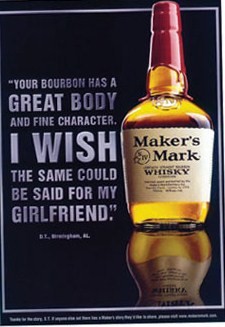| The Maker's Mark advertisement is fairly
straightforward in its attempt to relate the alcohol to a woman, and is
actually demeaning to women in the process. The layout of the ad is
text on the left side and the mortise of the bottle on the right. The
mortise actually plays more of a role in that it is not simply there to
show what the bottle looks like but there is a reflection of it
underneath. It's reflection shows it with a womanly figure. The reason
that it does is because the text reads, "Your bourbon has a great body
and find character. I wish the same could be said for my girlfriend."
Men reading this may either agree that their girlfriends don't have a
good body of character, may disagree, or may not even have a girlfriend.
Either way, they understand that the alcohol is described well and that
women are not. The ad is relating this alcohol to women by having the
reflection shaped in the form of a woman with a small waist like an
hourglass figure. The way that the text and mortise are placed is what
Kress and Van Leeuwen deem the given and the new. The given "means that
it is presented as something the viewer or reader already knows" (Jewitt
and Oyama; 148) The statement about the girlfriend not have a "fine
character" and a "great body" should therefore be something that the
reader already knows. He may already know that his girlfriend does not
have these qualities or think that many women don't either. The new, or
the bottle with the hourglass reflection should be the information that
is not already known to the viewer. He may not have known what the
bottle looked like, or that it has those qualities as described by the
text. |  |





